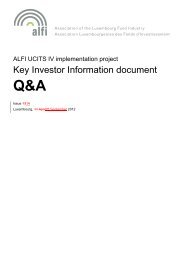Real Estate Investment Funds: Financial reporting - Alfi
Real Estate Investment Funds: Financial reporting - Alfi
Real Estate Investment Funds: Financial reporting - Alfi
You also want an ePaper? Increase the reach of your titles
YUMPU automatically turns print PDFs into web optimized ePapers that Google loves.
property valuation<br />
1. What are acceptable<br />
valuation methods for<br />
investment property?<br />
a. The actual cost of a recent acquisition.<br />
b. Estimations made based on the cost of<br />
comparable transactions in a similar location<br />
and condition, often using a unitised method<br />
(e.g. value per square meter), or of a dissimilar<br />
property adjusted to reflect the differences.<br />
c. Discounted cash flow of future income<br />
and expenses.<br />
d. Multiples of annual rental income (rental yields).<br />
e. Any other method recognised by applicable<br />
valuation standards, e.g. depreciated<br />
replacement cost, profits method, fair value<br />
at completion less costs to complete,<br />
(applicable to properties under development).<br />
f. When determining the fair value of a<br />
property, lease adjustments, such as<br />
incentives, rent guarantees and insurance<br />
cover are usually taken into account.<br />
Attention should be paid to avoid double<br />
counting of such effects in the fair value of<br />
the property, when such effects are reflected<br />
as separate items on the balance sheet.<br />
2. What are the<br />
generally accepted<br />
frameworks for<br />
determining fair value<br />
for investment<br />
properties?<br />
a. CSSF Circular 91/75, and in other cases<br />
common and best practice (see Chapter VI.2),<br />
dictates that investment properties must be<br />
valued at least on an annual basis by an<br />
external valuer. There are no detailed<br />
guidelines specifying how this should be<br />
done; valuation rules are those as stated in<br />
the Fund Documentation. Best practice is to<br />
follow recognised property valuation<br />
standards such as IVSC/RICS /TEGOVA.<br />
If the financial statements are prepared in<br />
accordance with IFRS, then the valuation<br />
methodology should also comply with<br />
IAS 40 (<strong>Investment</strong> Property). IAS 40 regards<br />
current prices in an active market for similar<br />
property in the same location and condition<br />
and subject to similar lease and other<br />
contracts as the best evidence of fair value.<br />
In the absence of current prices in an active<br />
market, the standard considers information<br />
from a variety of sources including<br />
discounted cash flow projections based on<br />
reliable estimates of future cash flows.<br />
b. INREV Guidelines 2008 (in the following<br />
"INREV") provide further details on<br />
frameworks for performing property<br />
valuations for unlisted funds with the EPRA<br />
Best Practices Recommendations on<br />
Reporting of October 2010 providing<br />
guidance for listed funds.<br />
c. For open ended funds, independent and<br />
regular valuation of the properties is<br />
particularly important as this ensures that<br />
subscriptions and redemptions of units/shares<br />
are carried out based on a Fund NAV directly<br />
linked to the underlying property value.<br />
3. What is understood<br />
by the term ‘Fair Value’<br />
for investment property<br />
and is this always the<br />
same as ‘Market Value’<br />
as described in various<br />
property valuation<br />
standards?<br />
a. In the context of real estate, Market Value<br />
generally refers to the valuer’s opinion of the<br />
best price that could be obtained in the open<br />
market on an arms-length basis at a specific<br />
date, assuming a willing buyer and a willing<br />
seller, and assuming marketing has already<br />
taken place e.g. special interests and/or<br />
operational value to the business are not<br />
taken into account.<br />
b. Fair Value is the net present value of expected<br />
cash proceeds taken from the market value<br />
defined in Chapter I.3.a above, which is<br />
expected to be received from the disposal of a<br />
property under normal market conditions.<br />
This excludes transaction costs normally<br />
borne by a potential buyer from the appraised<br />
market value. In addition, costs which may be<br />
incurred by the seller on disposal of the<br />
property are not taken into account in both<br />
the fair value or in the market value.<br />
c. Under IFRS the determination of fair value<br />
generally does not take account of the method<br />
of disposal (i.e. always assumes that the<br />
property is sold as an asset deal from the<br />
company that owns it). Essentially, it is the value<br />
that the investors in the fund can expect to<br />
recover from the sale of a property, as estimated<br />
at the date of the financial statements.<br />
d. Although LuxGAAP generally follows IFRS<br />
rules, under LuxGAAP and INREV<br />
guidance, the method of disposal in certain<br />
circumstances could possibly be taken into<br />
account, e.g. the effect of a possible sale of<br />
shares of a property vehicle, rather than a<br />
property, reducing the actual transfer tax<br />
and/or purchasers costs to be paid upon sale<br />
6

















